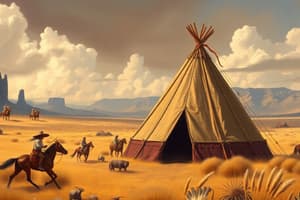Podcast
Questions and Answers
What was a significant effect of the discovery of gold in Colorado in 1858?
What was a significant effect of the discovery of gold in Colorado in 1858?
- It sparked the phrase 'Pike's Peak or Bust'. (correct)
- It led to a decline in the population of the region.
- It decreased the demand for railroads.
- It resulted in the immediate establishment of state governments.
Which policy was NOT advocated by supporters frustrated with Wall Street and industrial monopolies?
Which policy was NOT advocated by supporters frustrated with Wall Street and industrial monopolies?
- Nationalizing telecommunications.
- Implementing a flat income tax. (correct)
- Graduated income tax.
- Free and unlimited coinage of silver.
What was a common issue faced by cowboys during cattle drives in the late 19th century?
What was a common issue faced by cowboys during cattle drives in the late 19th century?
- Competition with railroads for transportation.
- Scarcity of cattle due to overpopulation.
- Limited access to shelter during drives.
- Harsh weather impacting grazing availability. (correct)
What misconception did many people have about the Plains during the era of the Homestead Act?
What misconception did many people have about the Plains during the era of the Homestead Act?
What did the term 'sodbusters' refer to in the context of agriculture on the Plains?
What did the term 'sodbusters' refer to in the context of agriculture on the Plains?
What was NOT a consequence of the Homestead Act of 1862?
What was NOT a consequence of the Homestead Act of 1862?
What is implied about the relationships between people in the passage?
What is implied about the relationships between people in the passage?
What metaphor does Chief Joseph use to describe the confinement of individuals?
What metaphor does Chief Joseph use to describe the confinement of individuals?
What does Chief Joseph suggest is necessary for growth and prosperity?
What does Chief Joseph suggest is necessary for growth and prosperity?
What is Chief Joseph's stance on the authority of white leaders over Native Americans?
What is Chief Joseph's stance on the authority of white leaders over Native Americans?
What emotional response does Chief Joseph express toward empty promises?
What emotional response does Chief Joseph express toward empty promises?
According to Chief Joseph, how should all men be treated?
According to Chief Joseph, how should all men be treated?
What underlying message can be inferred from the statement 'the earth is the mother of all people'?
What underlying message can be inferred from the statement 'the earth is the mother of all people'?
What does the phrase 'expect all rivers to run backward' symbolize in the context of the passage?
What does the phrase 'expect all rivers to run backward' symbolize in the context of the passage?
What is the tone of Chief Joseph's reflections on the situation of Native Americans?
What is the tone of Chief Joseph's reflections on the situation of Native Americans?
What was the primary purpose of the Dawes Severalty Act of 1887?
What was the primary purpose of the Dawes Severalty Act of 1887?
What did Custer's Last Stand signify in the context of conflicts between Natives and U.S. troops?
What did Custer's Last Stand signify in the context of conflicts between Natives and U.S. troops?
Which movement aimed to improve the social conditions and economic situation of farmers during this period?
Which movement aimed to improve the social conditions and economic situation of farmers during this period?
What was a significant criticism of the Populist movement?
What was a significant criticism of the Populist movement?
Which event was specifically aimed at suppressing the spiritual movement known as the Ghost Dance?
Which event was specifically aimed at suppressing the spiritual movement known as the Ghost Dance?
What did the Grange Movement shift its focus towards over time?
What did the Grange Movement shift its focus towards over time?
What did 'Custer's Last Stand' demonstrate about Native American resistance?
What did 'Custer's Last Stand' demonstrate about Native American resistance?
What role did Buffalo Soldiers play in the context of U.S. military history?
What role did Buffalo Soldiers play in the context of U.S. military history?
What did Helen Hunt Jackson's 'A Century of Dishonor' focus on?
What did Helen Hunt Jackson's 'A Century of Dishonor' focus on?
What was a key goal of the Farmers' Alliance?
What was a key goal of the Farmers' Alliance?
Flashcards
Equality for all
Equality for all
The belief that all people, regardless of their race or background, should have equal rights and opportunities.
Heart sick
Heart sick
A strong feeling of sadness and disappointment, often caused by betrayal or unfulfilled promises.
Penned up
Penned up
A feeling of confinement and lack of freedom, like being trapped or restricted.
Reservation
Reservation
Signup and view all the flashcards
Sioux War
Sioux War
Signup and view all the flashcards
Geronimo (Apache Chief)
Geronimo (Apache Chief)
Signup and view all the flashcards
Chief Joseph (Nez Perce)
Chief Joseph (Nez Perce)
Signup and view all the flashcards
Great White Chiefs
Great White Chiefs
Signup and view all the flashcards
Talking
Talking
Signup and view all the flashcards
Populism
Populism
Signup and view all the flashcards
Free Silver
Free Silver
Signup and view all the flashcards
Homestead Act (1862)
Homestead Act (1862)
Signup and view all the flashcards
Bonanza Farms
Bonanza Farms
Signup and view all the flashcards
Long Drives
Long Drives
Signup and view all the flashcards
Boomtowns
Boomtowns
Signup and view all the flashcards
Post-Civil War Plains Indian Land Surrender
Post-Civil War Plains Indian Land Surrender
Signup and view all the flashcards
A Century of Dishonor
A Century of Dishonor
Signup and view all the flashcards
Dawes Severalty Act
Dawes Severalty Act
Signup and view all the flashcards
Battles on the Plains
Battles on the Plains
Signup and view all the flashcards
Custer's Last Stand (Battle of Little Bighorn)
Custer's Last Stand (Battle of Little Bighorn)
Signup and view all the flashcards
Battle of Wounded Knee
Battle of Wounded Knee
Signup and view all the flashcards
Buffalo Soldiers
Buffalo Soldiers
Signup and view all the flashcards
Grange Movement
Grange Movement
Signup and view all the flashcards
Farmers' Alliance
Farmers' Alliance
Signup and view all the flashcards
Populist Party
Populist Party
Signup and view all the flashcards
Study Notes
The West (1865-1900)
- This period saw significant development and conflict in the American West.
- The government, through policies like the Homestead Act, encouraged westward expansion and settlement.
- Manifest Destiny influenced the movement of settlers westward.
- The U. S. government violated treaties and agreements with Native American tribes, leading to forced removal and conflicts.
- Conflicts between white settlers and Native American tribes were frequent and often violent. Key examples include the Custer's Last Stand, the Battle of Wounded Knee.
- The westward expansion was also driven by the discovery of valuable resources like gold and the building of railroads.
- The mining industry spurred economic growth and population growth in the West.
- 1858 gold was discovered in Colorado (Pike's Peak or Bust).
- The Comstock Lode (1859) in Nevada led to a boom.
- Boomtowns arose, characterized by a mix of opportunity and lawlessness.
- Mining wealth financed the Civil War, railroads, and specie payments.
- Ranching developed as a major industry with long drives of cattle across the open plains.
- Cowboys, including white, Black, and Mexican herders, played a crucial role in this industry.
- The harsh climate and encroaching settlers challenged ranching.
- The Homestead Act (1862) allowed settlers to claim land in exchange for living on and improving it. This encouraged migration and farming.
- Early settlers encountered difficulties with agriculture in the West.
- New technologies such as plows and barbed wire enabled farming on the prairies.
- The Granger Movement and Farmers' Alliance aimed to improve the plight and concerns of farmers in the West.
- Populism emerged as a political movement representing farmers.
- Frustration with industrialists and financial institutions gave rise to the Populist movement.
- The Populist movement advocated for reforms like the nationalizing of railroads and a graduated income tax.
- The Populist Party's presidential candidate, James B. Weaver, achieved some success in the West but faced challenges in broader elections.
- The destruction of buffalo herds severely impacted Native American cultures and economies.
- This destruction was largely a consequence of westward expansion and progress.
- The development of the West was complex, involving both opportunities and conflicts.
Studying That Suits You
Use AI to generate personalized quizzes and flashcards to suit your learning preferences.




